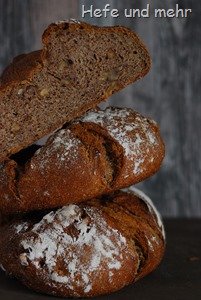 Oliver asked me on Saturday morning if I have a recipe for a “King Ludwig Bread”. I did not know a bread with this name, but after some minutes of googling I started to suspect that it is a readymade mixture for bakeries, as so many bakeries are selling it. Some minutes later I found the manufacture of the mix and the ingredients did not sound so well in my ears: “Spelt flour, ry flour, malt, dried rye sourdough, whole spelt flour, coarse meal spelt, gluten, salt, sweet whey powder, guar flour, wheat bran, grape concentrate, ascorbic acid, enzymes”.
Oliver asked me on Saturday morning if I have a recipe for a “King Ludwig Bread”. I did not know a bread with this name, but after some minutes of googling I started to suspect that it is a readymade mixture for bakeries, as so many bakeries are selling it. Some minutes later I found the manufacture of the mix and the ingredients did not sound so well in my ears: “Spelt flour, ry flour, malt, dried rye sourdough, whole spelt flour, coarse meal spelt, gluten, salt, sweet whey powder, guar flour, wheat bran, grape concentrate, ascorbic acid, enzymes”.
The breads seems to have a soft crumb what speaks against a bigger amount of rye and the brownish crumb should be due to malt and not to a lot of whole grain flour. And slowly a recipe starts to appear in my brain.




 I hope that you did not start to think that there is no bread baked in our hose anymore. But the hot weather and the start into a new job make me bake less. So we emptied the bread drawer in our freezer (very good, more room for new bread) and I baked “old” favourite recipes like
I hope that you did not start to think that there is no bread baked in our hose anymore. But the hot weather and the start into a new job make me bake less. So we emptied the bread drawer in our freezer (very good, more room for new bread) and I baked “old” favourite recipes like “Eingenetztes Brot” would be Net-Bread if translated literally. But the origin from the word “eingenetzt” does not stem from the German “Netz” (net) but from “Nass”, which means “Wet”. And making the bread is wet indeed. The sticky dough is easiest to handle when hands and tools are really wet. When the bread is placed in the oven its surface is wet as well. This helps to create the shiny crust which is characteristic for this bread. To get the soft dough in the oven without accident, a so called “Schapf”, a kind of ladle, is used traditionally. Even in my rather big kitchen collection, there is no “Schapf” and so I used a small salad bowl instead. And this worked fine!
“Eingenetztes Brot” would be Net-Bread if translated literally. But the origin from the word “eingenetzt” does not stem from the German “Netz” (net) but from “Nass”, which means “Wet”. And making the bread is wet indeed. The sticky dough is easiest to handle when hands and tools are really wet. When the bread is placed in the oven its surface is wet as well. This helps to create the shiny crust which is characteristic for this bread. To get the soft dough in the oven without accident, a so called “Schapf”, a kind of ladle, is used traditionally. Even in my rather big kitchen collection, there is no “Schapf” and so I used a small salad bowl instead. And this worked fine! The new Sourdough is ready to bake our first sourdough bread. As a freshly raised sourdough is still a little bit weak, it makes sense to do one (or even better two) sourdough feedings at warm temperature to
The new Sourdough is ready to bake our first sourdough bread. As a freshly raised sourdough is still a little bit weak, it makes sense to do one (or even better two) sourdough feedings at warm temperature to 
 So here is now the promised Spelt bread. I know that many of the readers of this blog like to bake with spelt, but baking with spelt flour is a little bit more challenging then baking with wheat flour, so the recipe comes relatively late in my bread baking course.
So here is now the promised Spelt bread. I know that many of the readers of this blog like to bake with spelt, but baking with spelt flour is a little bit more challenging then baking with wheat flour, so the recipe comes relatively late in my bread baking course.